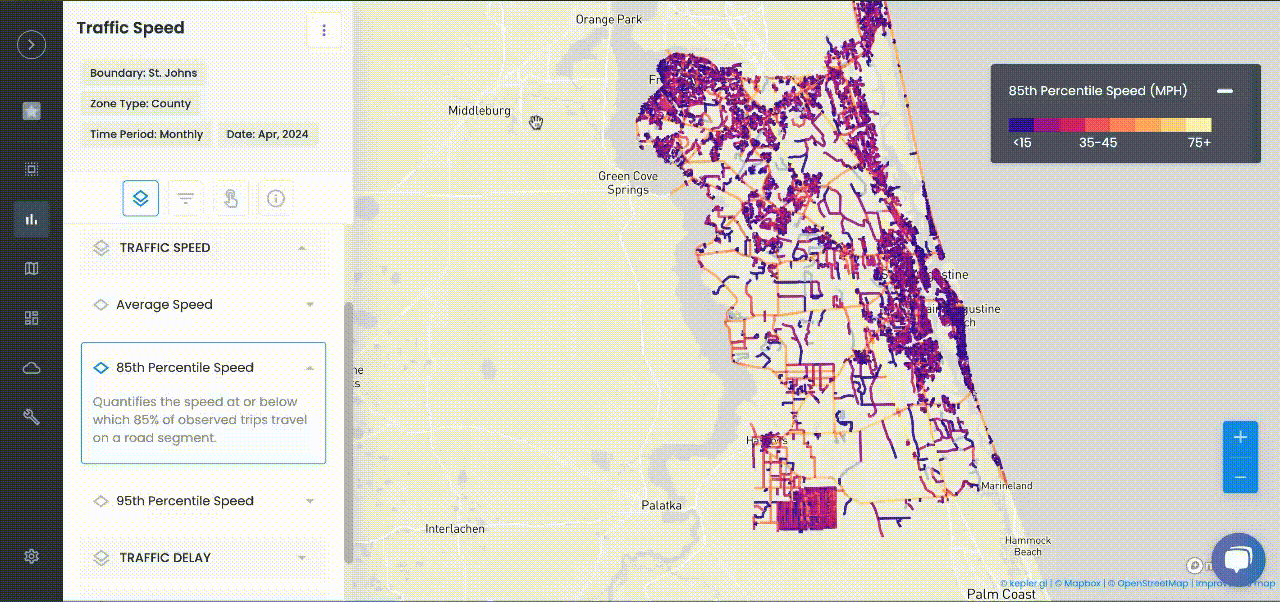
Road Safety
Case Studies: How Cities Use Traffic Safety Software to Reduce Accidents
See how cities use Urban SDK’s traffic safety software to target hotspots, curb speeding, and save lives.
See how cities use Urban SDK’s traffic safety software to target hotspots, curb speeding, and save lives.
Across the country, city planners and transportation officials are turning to data-driven traffic safety software to create safer streets. With the rise in crashes and speeding complaints, tools like Urban SDK’s traffic safety solutions empower agencies to identify danger zones, monitor speeds in real-time, and proactively prevent collisions.
By analyzing trends and engaging the public with transparent data, these cities are shifting from reactive fixes to measurable, proactive safety improvements. Let’s take a look at how several communities are using Urban SDK’s traffic safety software to reduce accidents, curb speeding, and even save lives.
Kirkwood, Missouri – Vision Zero Goals Backed by Speed Analytics
Kirkwood, a suburb of St. Louis, showcases a city committed to ambitious safety goals backed by solid data. In 2022, Kirkwood embraced Vision Zero, pledging to eliminate traffic fatalities. By 2023, they secured a $480,000 federal Safe Streets for All grant to help realize that dream.
To support these efforts, Kirkwood partnered with Urban SDK to leverage data effectively. With Urban SDK, city officials can now monitor traffic speeds across all local roads in real-time and swiftly identify high-risk areas, leading to faster responses to citizen speeding complaints. This comprehensive approach allows the city to diagnose and prioritize at-risk roadways instead of relying solely on anecdotal feedback.
By joining Urban SDK, Kirkwood has become part of a growing network of over 100 agencies nationwide that are using data to create safer, more walkable streets. While results are still emerging, Kirkwood's data-driven strategy sets the stage for significantly reducing crashes by addressing problems before they lead to tragedies.
Athens-Clarke County, Georgia – Data-Driven Traffic Calming Initiatives
In Athens-Clarke County, GA-home to the University of Georgia-officials faced increasing public concerns about speeding in residential neighborhoods. To enhance their traffic calming efforts, the county adopted Urban SDK’s platform to integrate hard data into planning and evaluation.
This platform enables the county to monitor traffic patterns before and after implementing changes like speed humps and roundabouts, ensuring that each project effectively slows cars down. Urban SDK provides staff with tools to track pre- and post-implementation metrics, allowing for direct comparisons of speeds or crash counts on streets before and after new measures like speed bumps.
As a result, Athens-Clarke can quantitatively assess the effectiveness of each safety intervention and make adjustments as necessary. The platform also facilitates targeted speed studies and validates citizen-reported speeding complaints using accurate, real-time data instead of just hearsay.
This approach not only enhances safety but also saves staff time by streamlining data collection and analysis. In essence, Athens-Clarke County is fostering a virtuous cycle: data-driven traffic calming leads to safer roads, building public trust that complaints are addressed based on facts, not guesswork.
Folsom, California – Proactive Hotspot Management and Public Trust
Folsom, CA, with a population of around 82,000, experienced a surge in traffic complaints from residents regarding speeding and congestion. Previously, city staff had to perform manual traffic studies and even contemplated hiring additional personnel to keep up.
Instead, Folsom embraced Urban SDK’s traffic safety analytics tool to optimize their efforts. The platform automatically identifies traffic safety “hotspots”—locations with unusual speeding or frequent crashes—allowing officials to prioritize these areas for intervention.
With real-time speed and volume data from Urban SDK, Folsom can quickly validate reported problem areas and implement targeted safety measures, whether that's enforcement or engineering fixes. This proactive stance has eliminated the lengthy wait times of setting up radar trailers or contracting studies, enabling city staff to gain insights within minutes.
Folsom can show residents the impact of new measures, such as how a road diet reduced average speeds, fostering a sense of accountability. As one of over 20 California communities using Urban SDK, Folsom is “leveraging technology to enhance road safety, reduce congestion, and improve community trust” in traffic management.
Camas, Washington – Identifying Crash Hotspots with Risk Scoring
The City of Camas, WA, home to about 26,000 residents near the busy Portland-Vancouver metro area, needed a smarter way to prioritize its traffic safety efforts across a network of local roads. With both neighborhood speeding complaints and crash-prone intersections, Camas faced significant challenges.
By working with Urban SDK, Camas gained a street-by-street risk map that quantifies where the worst problems are likely to occur. Urban SDK compiles five years of crash data, traffic speeds and volumes, and roadway characteristics to assign each road segment a collision risk score from to 1 as part of its Collision Index.
This means city engineers can quickly identify which corridors are high-risk outliers instead of guessing. Armed with these risk analytics, Camas can spot speeding and crash hotspots at a glance and allocate police patrols or traffic calming measures to the most dangerous areas first.
Importantly, Camas officials also use the system to track results over time. They analyze before-and-after data on streets where interventions have been made—such as whether average speeds dropped after a speed table was installed and if the collision index improved. This feedback loop enables the city to confirm the effectiveness of safety projects and adjust strategies when necessary.
Sanford, Florida – Real-Time Analytics Save Time and Lives
Traffic safety software isn't just for larger cities—smaller communities like Sanford, FL, with a population of around 60,000, are also experiencing substantial benefits from these data-driven tools. Sanford, which has a Vision Zero goal to reduce crashes, faced budget constraints that limited extensive field studies.
With Urban SDK, Sanford’s transportation team was able to skip expensive speed studies by tapping into existing data feeds and analytics. According to one public works director in Florida, Urban SDK provides “easy access to quick, reliable data,” so teams can assess road safety issues immediately, rather than waiting weeks for manual traffic counts.
This means tasks that once took a month—like deploying counters and analyzing numbers—can now be accomplished in just a few clicks. For Sanford, this rapid insight has been transformative; staff can immediately respond to citizens’ concerns about speeding, armed with charts showing actual speeds and traffic volumes.
This responsiveness builds public confidence and allows staff to focus on solutions rather than data collection. Sanford also utilizes Urban SDK’s analytics to bolster grant applications and safety plans. If community leaders propose a new crosswalk or urge a lower speed limit, planners can access the segment’s risk score, crash history, and 85th-percentile speed data to justify the need for such measures.
Using data to justify projects has enabled city officials to make quicker decisions and secure funding by demonstrating the potential life-saving impact of each initiative. By embracing real-time analytics and predictive risk tools, Sanford is accomplishing more with less-targeting critical dangers and preventing crashes before they happen.
Conclusion: Turning Data into Safer Streets
These case studies underscore a common theme: cities using real-time data and AI-powered analytics are witnessing tangible improvements in traffic safety. By identifying speeding issues and collision hotspots, these agencies can take swift action and effectively monitor the results.
The outcomes speak for themselves—cities that have implemented data-driven strategies report significant reductions in dangerous driving. For instance, one program in Nevada found that deploying AI-guided patrols and warning signs reduced crashes by 18% and decreased speeding by 43%. Another city's data-informed camera initiative saw total crashes drop by nearly 50%, with even larger declines in injury crashes.
Across the nation, transparent, evidence-based strategies are fostering public trust, as residents witness resources being directed to objectively high-risk locations, not just to those voicing the loudest complaints.
In summary, traffic safety software provides cities with a smarter, faster path toward achieving Vision Zero. The ability to continuously monitor conditions, prioritize interventions by risk, and measure impact empowers transportation officials to create safer roads, even within limited budgets.
City leaders and planners can take away several key lessons from these success stories:
- Use real-time speed and crash data to drive decisions—utilizing data helps pinpoint true problem areas and debunk “perception” issues, allowing efforts to focus on actual risks.
- Be proactive, not reactive—predictive analytics and risk scores identify areas where future accidents might occur, facilitating preventive measures before tragedies can occur.
- Measure and iterate—set clear metrics for every project and compare before/after statistics to confirm effectiveness.
- Engage the public with data—sharing straightforward maps and reports enhances credibility and fosters greater community buy-in.
To see more real-world examples from cities like Kirkwood, Athens-Clarke, Folsom, Camas, and Sanford, explore our Urban SDK Case Studies library.

TRAFFIC ENFORCEMENT FEATURES
80% of citizen complaints
are a perception problem
Urban SDK provides precise hourly speed data to evaluate complaints and deploy resources efficiently for the greatest impact to public safety.
Urban SDK provides precise hourly speed data to evaluate complaints and deploy resources efficiently for the greatest impact to public safety.
Target Speeding
Identify hot spots, validate monthly speeding trends and monitor vulnerable areas like school zones.
Improve Safety
Crash and citations location information to compare speed trends month over month
Fast Response
Respond to citizen complaints sooner with address search and exportable reporting
Deploy Assets
Generate maps for traffic enforcement by time of day, location or division to deploy officers to known problem areas.
RESOURCES
Customer Success
See how public sector leaders succeed with Urban SDK.
WEBINAR
Identify speeding and proactively enforce issues
See just how quick and easy it is to identify speeding, address complaints, and deploy officers.







